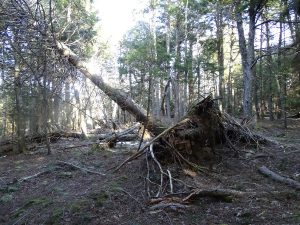While most of the L&F’s priority Projects addressing the Lahey recommendations appear to have lagged well behind the initial schedules posted on June 25, 2019, at least one clearly has not: the Natural Disturbance Regimes Project.
From the June 25, 2019 L&F Ecological Forestry webpage:
Natural Disturbance Regimes
- The department will publish a peer-reviewed assessment of Nova Scotia’s natural disturbance agents, like fires, floods, insect infestations and large storms.
- Professor Lahey recommended peer review of the department’s Natural Disturbance Regime methodology and mapping. Prior to undertaking this work the department will prepare a foundational paper on the natural disturbance agents for peer review.
- The assessment will be ready to be submitted for peer review this fall.
- This paper would then set the stage for a second paper specific to the mapping and methodology.
- The project team is led by Mark Pulsifer. The team includes department staff with expertise in the field, landscape level planning, biodiversity and resource management planning.
- Dr. David McLean and Dr. Anthony Taylor are external experts advising the project team. Dr. MacLean is Emeritus Professor at the Faculty of Forestry & Environmental Management, University of New Brunswick. Dr. Anthony Taylor is a forest ecologist with the Atlantic Forestry Centre, Fredericton.
I have just learned via the Medway Community Co-op Facebook Page that the paper cited above is now publicly available and can be downloaded free of charge from Environmental Reviews. View:
A review of natural disturbances to inform implementation of ecological forestry in Nova Scotia, Canada
by Anthony R. Taylor1,2*, David A. MacLean2, Peter D. Neily3, Bruce Stewart3, Eugene Quigley3, Sean P. Basquill4, Celia K. Boone5, Derek Gilby5, Mark Pulsifer3 Published on the web inEnvironmental Reviews Aug. 18, 2020
___________________
1 Natural Resources Canada, Canadian Forest Service – Atlantic Forestry Centre, 1350 Regent Street, PO Box 4000, Fredericton, New Brunswick, Canada E3B 5P7 (current affiliation)
2 Faculty of Forestry and Environmental Management, University of New Brunswick, 28 Dineen Drive, Fredericton, NB E3B 5A3, Canada
3 Nova Scotia Department of Lands and Forestry, 15 Arlington Place, Suite 7, Truro, Nova Scotia, Canada B2N 0G9
4 Nova Scotia Department of Lands and Forestry, Wildlife Division, 136 Exhibition Street, Kentville, Nova Scotia, Canada B4N 4E5
5 Nova Scotia Department of Lands and Forestry, Forest Protection Division, 23 Creighton Drive, Shubenacadie, Nova Scotia, Canada B0N 2H0
The paper is provided in its manuscript form – I guess it will appear in its final, journal form in the next issue of Environmental Reviews.
Comment added Sep 4, 2020. The paper by Taylor et al., relies heavily on a report by Ponomarenko (2018), cited in the references as
I requested the paper from L&F who directed me to the Natural Sciences Library; they did not have it but obtained it and will make it available in electronic form on request; contact Tracy Lenfesty (Librarian) <tracy.lenfesty@novascotia.ca>. It is 39 pages. The full title:
|
Interestingly the Current Issue of Environmental Reviews carries a paper on a closely related topic:
Borealization of the New England – Acadian Forest: a review of the evidence
by Josh Noseworthy and Thomas M. Beckley. Environmental Reviews 2020, 28(3): 284-293.
That paper cannot be freely downloaded (cost for one download: $30) however the authors’ manuscript is available separately from the University of Toronto TSpace.
I have read each paper once, they are packed full of info. ‘Will comment further when I have had time to fully digest them.
Both papers represent major advances in our understanding of forest ecology in Nova Scotia.
Congratulations and thanks to the authors all.

